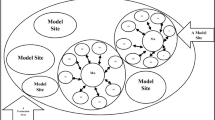Abstract
Fars Comprehensive Agricultural Database was created to remove bottlenecks and constrains of province for decision makers in a way that leads to sustainable agriculture. Regarding Fars agricultural comprehensive information database, and the importance of wheat as the strategic commodity, this study was conducted in Ali-Abad-e-Kamin (Pasargad, Iran) to assess two most important managerial factors affecting other agricultural factors. Therefore, in this study, besides evaluating the effect of water resource on wheat yield and other traits, education impacts were analyzed and evaluated as well. Data were collected regarding cadastre land use information derived from satellite imagery combined with GIS potencies, and also a comprehensive questionnaire was completed to collect local field information. Results revealed that educational level has significant effect on crop yield, fields’ area and seed consumption rate and also effect of water resource showed significant difference for crop yield, fields’ area. Finally, interactive effect of water resource and educational level showed significant difference just for wheat yield. Also, as a result, higher education positively results in improved wheat yield, lands’ area and seed consumption rate. On the other hand, river as a type of sustainable water resource with karstic geological formations positively affected wheat yield, lands’ area and farms distance from village. Overall, transferring knowledge from relevant organization resulting in higher productivity seems to be necessary.









Similar content being viewed by others
References
Agricultural statistics of Iran. (1996). Ministry of Agriculture. Bureau of statistics and information.
Akbari, M. (2007). Challenges and improvement wheat consultant engineers. M.Sc. Thesis, the University of Tehran. Faculty of Agricultural economics and Development.
Asadi, A., Akbari, A., Mohammadi, Y., & Hosseininia, G. H. (2010). Agricultural wheat waste management in Iran. Australian Journal of Basic and Applied Sciences, 4(3), 421–428.
Bagheri, A., & Shahbazi, E. (2003). Determining factors for educational needs of rural youth in sustainable exploitation of rice farms, a case study in A mol Township in the Province of Mazandaran. Iranian Journal of Agricultural Sciences, 34(3), 303–320.
Belensky, V. R. (1991). Return migration from cities to countryside, Land Reform Land Settlement and Co-operatives (pp. 74–82). Rome: Food and Agricultural Organization of the United Nations.
Comprehensive Assessment of Water Management in Agriculture (2007). Water for food, water for life: A comprehensive assessment of water management in agriculture. Earthscan, London. International Water Management Institute, Colombo.
Dubcovsky, J., & Dvorak, J. (2007). Genome plasticity a key factor in the success of polyploid wheat under domestication. Science, 316(5833), 1862–1866.
Galanopoulou, S., Facinelli, M., & Lorenzetti, F. (1996). General agronomic aspects of seed production. In A. J. G. van Gastel, M. A. Pagnotta, & E. Porceddu (Eds.) Seed science and technology. Proceedings of Train-the-Trainers Workshop Sponsored by Medcampus Programme (EEC), 24 Apr.–9 May 1993, Amman. Aleppo, Syria: ICARDA.
Gleick, P. H. (1993). Water in crisis: A guide to the world’s fresh water resources. Oxford: Oxford University Press.
Hassan, I., Chatta, M. B., Chatta, T. H. & Ali, M. A. (2010). Factors affecting wheat yield: A case study of mixed cropping zone of Punjab. Journal of Agricultural Research, 48, 403–408.
Huffman, W. E. (1974). Decision making: The role of education. American Journal Agricultural Economics, 56, 85–97.
Keshavarz, A., & Haydari, N. (2003). Attitude to water resource waste in Agricultural crops. In Conference proceedings. The first conference prevention methods of resource waste. Tehran.
Khatoonabadi, A. (1999). Interactive communication and water harvesting management within local communities: A participative action group approach, paper presented at the regional workshop on traditional Water harvesting systems, Tehran, Iran.
Kousari, M. R., & Ahani, H. (2011). An investigation of reference crop evapotranspiration trend from 1975 to 2005 in Iran. International Journal of Climatology. http://onlinelibrary.wiley.com/doi/10.1002/joc.3404/.
Kousari, M. R., & Asadi Zarch, M. A. (2011). Minimum, maximum, and mean annual temperatures, relative humidity, and precipitation trends in arid and semi-arid regions of Iran. Arabian Journal of Geosciences, 4, 907–914.
Lockheed, M. E., Jamison, D. T., & Lau, L. J. (1980). Farmer education and farm efficiency: A survey. Economic Development and Cultural Change, 29, 37–76.
Mohamed, E. S. (1996). Weed control in wheat. In O. A. Ageeb, A. B. Elahmadi, M. B. Solh & M. C. Saxena, (Eds.). Wheat Production and Improvement in the Sudan. Proc. National Research Review Workshop, 27-30 Aug. 1995, Wad Medani, Sudan. Aleppo, Syria, ICARDA/Agricultural Research Corporation, ICARDA.
Najafi, B. (1997). The final report of wheat marketing. Research institute of agricultural economic and planning, Tehran, Iran.
Postel, S. L. (1998). Entering an era of water scarcity: The challenges ahead. Ecological Applications, 10(4), 941–948.
Shultz, T. W. (1975). The value of ability to deal with disequilibria. Journal of Economic Literature, 13, 827–896.
Soufi, M. (2004). Morpho-climatic classification of gullies in Fars province, Southwest of I.R. Iran. In 13th International Soil Conservation Organisation Conference (pp. 4). Brisbane, Australia.
Weatherhead, E. K., & Howden, N. J. K. (2009). The relationship between land use and surface water resources in the UK. Land Use Policy, 26, 243–250.
Wheat Production and Improvement in the Sudan. (1995). In Proceedings of National Research Review Workshop, Aug 27–30, 1995, Wad Medani, Sudan. Aleppo, Syria: ICARDA/Agricultural Research Corporation, ICARDA.
WWAP. (2009). The United Nations World Water Development Report 3: Water in a changing world, World Water Assessment Programme. Paris/Earthscan, London: UNESCO Publishing.
Acknowledgments
The authors gratefully appreciate the Cadastre group (Management Center for Strategic Projects) in Fars Organization of Agricultural Jahad for their support and providing research facilities.
Author information
Authors and Affiliations
Corresponding author
Rights and permissions
About this article
Cite this article
Kherad, M., Ahani, H., Kousari, M.R. et al. Evaluation of education and water resource types on some wheat land features, using Fars Comprehensive Agricultural Database (case study; Pasargad, Iran). Environ Dev Sustain 15, 1129–1142 (2013). https://doi.org/10.1007/s10668-012-9428-7
Received:
Accepted:
Published:
Issue Date:
DOI: https://doi.org/10.1007/s10668-012-9428-7




